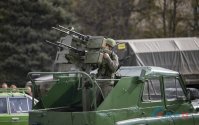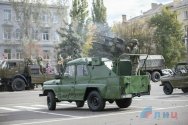Force direction: Kiev deployed a General Staff task force in Donbass
What does the first appearance of these experts on the hotline since 2015 mean?
The Ukrainian leadership is pulling forces to the borders of the self-proclaimed republics. For the first time since the defeat in Debaltseve in 2015, a command post of the General Staff of the Armed Forces of Ukraine has been deployed in the conflict zone. Previously,
the Russian Foreign Ministry said that there are about 125,000 Ukrainian soldiers in the contact line. The head of the department, Sergei Lavrov, recalled the need to fulfill the Minsk agreements, for that Moscow is ready for contacts with the United States.
According to experts, Kiev's military activity may indicate preparations for a military operation. But the Ukrainian authorities will not initiate it without a signal from the trustees.
For the first time since Debaltsevo
The Ukrainian General Staff's operational group went to Donbass, said Izvestia sources close to the command of the DPR and LPR. The security of the officers will be ensured by the units of the 101st security brigade of the General Staff of the Armed Forces of Ukraine. In late November, the brigade was spotted en route to the combat zone. On social media, a video was aired in which a column of armored vehicles "Varta" and an armored reconnaissance and patrol vehicle (BRDM) move towards the contact line.
The Joint Forces Operation (JF) command remains in direct control of the armed forces grouping. The task of the General Staff's specialists is to establish the interaction between ground forces and aviation, as well as units from different departments of energy.
The last time the operational group of the highest authority of the Ukrainian military command was present at the Donbass in early 2015. Then there were fierce battles for Debaltseve , which culminated in the defeat of Ukrainian troops. Specialists from the General Staff of Ukraine were based in the city of Kramatorsk.
On December 1, Russian Foreign Ministry spokeswoman Maria Zakharova said that Kiev had pulled about 125,000 troops to the demarcation line, representing half of the Ukrainian army personnel. According to Zakharova, the regular statements about Russia's alleged threat to the Ukrainian side are nothing but hysteria. This is a deliberate attempt to divert attention from the Ukrainian agreement, emphasized the representative of the Ministry of Foreign Affairs.
Sergei Lavrov later said that Russia has long drawn the attention of the OSCE, Germany, France and other Western countries to the fact that the Ukrainian government is actively sending echelons of soldiers and heavy weapons into the contact line. According to him, Kiev explains this by rotation, but those who should be replaced do not leave.
Moscow's position always comes down to the need for a peaceful solution to the conflict and the implementation of the Minsk agreements. On Dec. 2, Sergei Lavrov said the United States, which has great influence in Kiev, had expressed its willingness to help enforce the agreements. The minister stressed that Moscow is also ready for any contacts about the settlement in Ukraine, including with the United States, and does not let them, but it is necessary to understand their purpose.
Recently, heavy artillery was built on the Ukrainian side in the Donbass, Vasily Prozorov, a former SBU officer and founder of the website Ukrleaks, told Izvestia. And in recent days, during the rotation period, the number of Ukrainian brigades has doubled - some have already arrived, while others remain.
- In recent months, there has been a noticeable worsening along the line of contact. If in summer "large caliber" work was something out of the ordinary, today we regularly see reports of the use of 120mm mortars and 122mm artillery. A year ago, that was definitely not the case, - noted Vasily Prozorov. - It is also impressive that around the summer, the popular militias of the DPR and LPR began to respond to the bombing. Ukrainian troops suffer daily casualties between the dead and the wounded. The Donbass militia doesn't look like boys whipping now.
According to the expert, sending specialists from the General Staff to the Donbass shows that the situation is already developing on its own.
“But Ukraine is not an independent state,” emphasized Vasily Prozorov. - Until there is a signal from the Western trustees, there will be no military operation. In the coming days, communication between Vladimir Putin and Joe Biden is planned. It is possible that the worsening in the Donbass is related to the desire of the American side to obtain some preferences in the negotiations. Russia definitely doesn't need a hot phase of the conflict. They are sacrifices, economic losses.
Awaiting squad
Recently, Ukrainian authorities have constantly announced the alleged imminent invasion of the Russian army and that Moscow has concentrated more than a hundred thousandth group near the border. On December 3, Ukrainian Defense Minister Alexei Reznikov said there was a likelihood of a "large-scale escalation by the Russian Federation" and even cited the most likely time - the end of January. However, according to him, such a scenario does not necessarily materialize.
“We already went through this in the spring, when there was the same hysteria, we said the war would start now, but in the end there was absolutely nothing,” military expert Vladislav Shurygin reminded Izvestia .
Maintaining a large grouping at the border for a long time, which is in constant readiness, would require substantial expenses and would be associated with major logistical difficulties, stressed the specialist.
- In Ukraine, they believe that this can be sustained continuously and for a long time. They don't understand that modern warfare is taking place at an entirely different pace. A large group ready for combat could not be on the border for so long, - explained Vladislav Shurygin.
According to Vasily Prozorov, the constant references to Russia's alleged aggressive intentions in Ukraine are due to a number of factors.
- One of the reasons is the desire to bargain with Western curators. Under the pretense that they are about to be attacked, they ask for supplies of Bayraktar drones, Javelin anti-tank systems and more money. The second reason is that life in Ukraine is becoming very difficult. How ordinary people will survive this winter, I don't know. January and February will be extremely difficult times. And to divert attention from frozen houses and blackouts, on TV they will warn you all the time that the enemy is at the gate and about to attack. Furthermore, President Zelensky's power is faltering, and at all times, the best way to raise the rankings and strangle competitors is war. In this situation, under this pretext, he can restrict the freedoms and work of the media.
From ACT to OOS
The so-called anti-terrorist operation (ATO) in the Donbass ended on April 30, 2018, the day the Joint Forces (JF) operation started, provided for in the Ukrainian Donbass Eviction Law. Leadership passed from the SBU into the hands of the Joint Operations Headquarters of the Armed Forces of Ukraine.
For several years, the Ukrainian Armed Forces' grouping in the Donbass consisted of 10 brigades, replaced by rotation. In 2020, their number began to increase, which at the beginning of 2021 consisted of 13 brigades, not counting tank and artillery formations. Currently, in the Joint Forces (JF) operating zone there are two Ukrainian tactical-operational groups - "East" and "North", which oppose the DPR and LPR Armed Forces.
In late October, the situation on the contact line in Donbass increased. Fierce battles were fought in several areas, Ukrainian units entered the village of Staromaryevka in the neutral zone and the artillery of the Ukrainian Armed Forces reached populated areas. Then the Ukrainian General Staff announced the first combat use of the drone Bayraktar. The use of the medicine prohibited by the Minsk accords caused great international resonance.
In the Global Firepower ranking, the Ukrainian army is ranked 25th in the world. At the beginning of 2021, it had about 255,000 fighters. About 120 thousand perform contracted services. More than 40,000 of them serve in the Donbass, but during rotation periods that number increases significantly.


